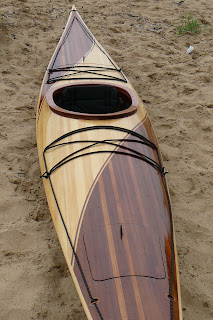Moraine State Park
April 7, 2011
YES!!!
She's not sinking... my boat floats.
Okay, I'm not exactly surprised. In fact, I fully expected that result. Even so, after these past four months of regular ship-wrighting, it was gratifying to witness a positive outcome.
It had been several weekends of horrendous weather in these parts combined with the effects of a serious cold which conspired to delay the much awaited test launch.

Today, finally, on the tail end of my cold but with a brief opening in the weather window, I hooked up the trailer after a shortened day at work and headed up to Moraine State Park.
My first stop was at the Park Office in order to purchase a launch permit. Let's not risk the Park Warden confiscating my little lug-rig on its first day at sea, shall we?
Temps at 58 with cotton-ball skies and winds between 5-7 knots, it turned out to be an ideal first outing for this little pram-pup.
I wanted this first day to be private without audience and outside of a gazillion water foul, I found myself unobserved, able to mess leisurely with all the details of getting ready and figuring out

what to put where
and attach how etc.
Of course, on the down side, no action pictures of boat and skipper under away. That's for another time.
The launch was a cinch!
The wheel hubs did not even have to touch the water. I slightly lifted the bow and that cause the skegg of the boat to slide off the trailer rear roller... and off she swooshed into the water.
The rounded shape of the hull (without human ballast on it) makes it appear as though it's only skimming the water like a swallow briefly dipping into the waves in flight.
After raising the lug sail, inserting the dagger board and securing the oars, I pushed off. True, not much wind is needed to make her move. However, movement is all relative, isn't it? On one hand, she heeled nicely on easy puffs and conveyed the lovely sense of speed. Yet, after ten minutes of sailing on the same beat, I find that our little lake has gotten a whole lot bigger when sailed in the little nutshell.
Of course, as I freely admitted in the opening post of this blog,
I am accustomed to hi-speed action on my Johnson-18 which readily jumps on a plane and under asymmetrical spinnaker broad reaches easily clocks close to 20 knots. I have no doubt that even a Sunfish would sail rings around the pram - and most certainly Garth's Goldberry.
As I develop a more intimate knowledge of the sailing characteristics of this design and the balanced lug-rig, I will talk shop in more detail. In the meantime, let it be said that I simply love the way it feels sailing the boat. The gurgles of the wavelets against the lap-strake hull are music to my ears. And - I love the simplicity of the lug-rig.
And one wonderful surprise! I discovered that the boat - perhaps aided by the tan-bark lug-sail - appears to provide an excellent camouflage cover for birding. Water foul was not alarmed at the sight of an approaching nutshell, bobbing along nearby. I had brought along my binoculars and spotted two pair of Northern Shovelers... not exactly that common to see in Moraine State Park. As I kept my lenses peeled on the closer pair, I failed to realize in my fascination that I was getting exceedingly close to a flock of about 200 double-crested Cormorants until a couple of them drifted into my view.
What a sight! Obviously, at one point, one Cormorant cawed to the other: this is getting too close for comfort... and started the mass movement, 200 large black birds, flying very low and close around me. Jaw-dropping view! I was in awe.
It was time to return and while winds had been sufficient to work the lug-rig, half-way back to the dock, I decided to drop canvas and try rowing. Around the dock there is generally little to no wind as was the case today or fluky puffs from all directions.
Dropping the lug rig is a piece of cake and you can easily stow it on the side out of the way. So, out come the oars and off you go ~~~ tracking rather beautifully.
The pram is a hybrid craft - neither a pure sailboat nor a pure rowboat. Instead, it is an all-around little ship to mess around in. It does both things quite nicely as long as you don't have false expectations.
I much enjoyed rowing my little vessel back to shore and happily declare the first outing a success.
















































